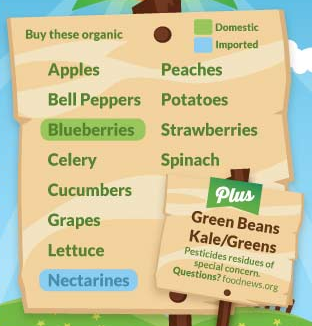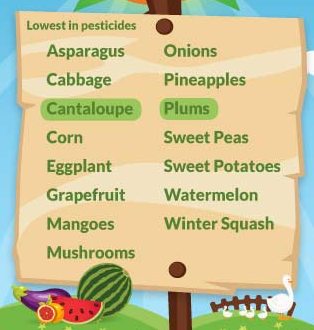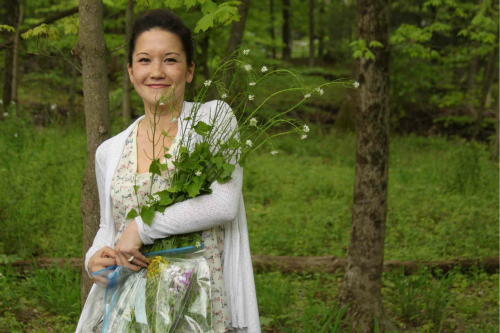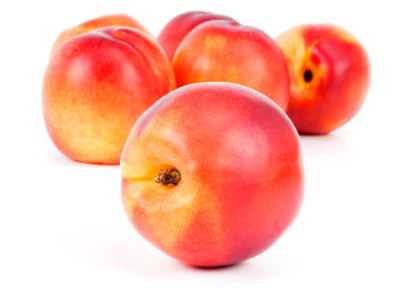
The Dirty Dozen list includes the produce with the most pesticide residue. Click to download the full guide.
Every year, the Environmental Working Group (EWG) releases a new version of its Shopper’s Guide to Pesticides just as I start gearing up to fill my gullet with watermelon, peaches, and tomatoes.
That’s right, it’s peak produce season, and — unless you eat everything 100 percent organic all the time — pesticide residue is a valid concern. What’s more, not all conventionally grown fruits and vegetables pose the same risk. The EWG site ranks 45 foods and pulls out the best and worst on the list. “The Dirty Dozen” are the foods most likely to be coated with pesticide residue (peaches happen to be No. 4 on the list, while apples have earned the No. 1 spot for several years running). “The Clean 15” are the foods (including onions, corn, and avocados) that are safest for consumers.
Of course, as I’ve written before, this list doesn’t necessarily correspond to the amount of pesticides used to grow the food. Many of the crops on the Clean 15 list still require a hefty dose of toxic chemicals, which still have an impact on the soil, groundwater, and wildlife around them — not to mention the people who work on farms and live in the surrounding communities. Those chemicals just don’t make it to your plate as readily, for a variety of reasons.
All that said, EWG’s Dirty Dozen and Clean 15 lists are incredibly useful for the imperfect among us. In other words, they’re made for those who’d like to manage their pesticide exposure but cannot — for reasons of cost or access — buy everything organic.
This year’s list is also officially called “Dirty Dozen Plus.” EWG has made it a point to highlight two additional foods — green beans and leafy greens (kale and collards) — because both tend be treated with highly toxic organophosphate insecticides.

The “Clean 15” list
Johanna Congleton, senior scientist at EWG, says that these chemicals raise a big red flag even in small doses. And although they have been largely phased out of agricultural use over the past decade, they’re not gone completely.
“We’re especially worried about organophosphates, because a body of science tells us they act as neurodevelopmental toxins,” she says.
Congleton also points to a study that shows that organophosphates are associated with lower birth weight and decreased gestational age (the time between conception and birth). EWG scientists say there is also evidence that these specific pesticides have been linked to cognitive problems. “This is a concern — especially to infants and pregnant women,” Congleton says. Considering the fact that kale is “the new bacon” and green beans are commonly used in baby food, she and her colleagues felt it was worth drawing extra attention to these two foods.
After several years of attacks from Alliance for Food and Farming — a group made up of large agribusiness groups (among them the California Strawberry Commission and the California Table Grape Commission), EWG also now makes it a point to stress the importance of vegetables, regardless of their pesticide load. Their site reads:
Eat your fruits and vegetables! The health benefits of a diet rich in fruits and vegetables outweigh the risks of pesticide exposure. Use EWG’s Shopper’s Guide to Pesticides to reduce your exposures as much as possible, but eating conventionally-grown produce is far better than not eating fruits and vegetables at all.
Today — as in years past — the Alliance for Food and Farming is releasing a report that appears timed to coincide with the new Shopper’s Guide to Pesticides called “Scared Fat: Are Consumers Being Scared Away from Eating Healthy Foods?”
And while the premise is a creative one, it’s also fairly condescending to eaters. Are we supposed to believe that most shoppers think it’s a good idea to switch from produce to junk food out of a fear of pesticides?
As EWG’s Alex Formuzis sees it, the guide’s audience — which now numbers in the millions, due to a combination of online and analog distribution — is just plain smarter than that. “People who use our list are already committed to eating fruits and vegetables,” he says. “They just want to make the best choices possible.”




